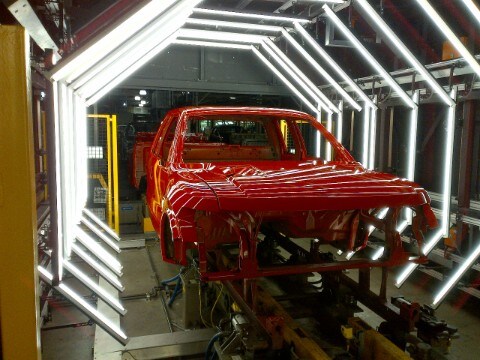
- With 1,400 new jobs and a $555 million investment, Flat Rock Assembly Plant begins Ford Fusion production
- Production added to improve tight availability of Ford Fusion; U.S. Fusion sales up 13 percent this year
- Ford will hire almost 6,500 workers in the U.S. this year to support
new products, growth and investment; company has added more than
three-quarters of the 12,000 hourly jobs it committed to add in the U.S.
by 2015
Supported by 1,400 new employees, the new Ford Fusion will roll off
the line at Flat Rock Assembly Plant today, marking the first time the
popular car has been built in the United States.
The move expands Fusion availability by more than 30 percent – up to
350,000 units annually – as the midsize sedan is setting sales records
for Ford.
“With its bold design and great fuel economy, Fusion has exceeded all
of our expectations, with demand outstripping supply,” said Joe
Hinrichs, Ford president of The Americas. “Fusion in Flat Rock is a win
for all of our stakeholders – including customers, employees and
dealers. At the same time, Ford is continuing its massive investment in
America by creating another 1,400 jobs.”
The 1,400 new employees Ford hired to support added production at
Flat Rock Assembly Plant puts the company more than 75 percent of the
way toward its goal of creating 12,000 hourly jobs in the United States
by 2015. In 2013 alone, Ford is hiring nearly 6,500 new hourly and
salaried employees in the U.S. to support products, growth and
investment.
Strong Fusion sales
Fusion sales – up 13 percent in the U.S. this year – remain very strong.
Through July, Ford sold more than 181,000 Fusions, 21,000 more than
were sold in the same period last year. Fusion vehicles are selling in
fewer than 20 days in such key markets as San Francisco, Los Angeles and
Miami,
Demand for Fusion is growing as the sedan continues to win over
buyers from other automakers, particularly Asian manufacturers, with a
competitive conquest rate of 50 percent.
Fusion has earned accolades from customers and influential
publications, winning seven major awards in its first nine months of
production.
Featuring a sleek silhouette and fresh face, the new Fusion is the
latest in a series of vehicles from Ford – following the 2011 Fiesta
subcompact and 2012 Focus small car – developed to serve customers who
want leading fuel efficiency, smart technologies and game-changing
design.
Fusion is the first sedan to offer gasoline, hybrid and plug-in
hybrid powertrains, underscoring Ford’s commitment to give customers the
power of choice. Fusion Hybrid is EPA-certified with a best-in-class 47
mpg city, 47 mpg highway and 47 mpg combined fuel economy rating.
Customers can choose from Fusion’s widest-ever portfolio of fuel-efficient powertrains, including EcoBoost
® gasoline-powered, hybrid and plug-in hybrid, automatic and manual transmission offerings and Auto Start-Stop technology.
With seven must-have technologies – including a Lane-Keeping System,
adaptive cruise control, active park assist and MyFord Touch
® – Fusion demonstrates Ford’s commitment to deliver features customers truly want and value in their vehicles.
Flat Rock transformation
“We are thrilled to have added production of Fusion at Flat Rock
Assembly Plant – not just for our dedicated workforce here, but for the
entire metro Detroit community and the associated jobs it will create,”
said UAW Vice President Jimmy Settles. “Together with the domestic
automakers and through the collective bargaining process, we are able to
bring jobs to the U.S. that were previously located offshore. Fusion
production in Flat Rock is a key part of that.”
To prepare Flat Rock’s newest hires to build Fusion, a
simulated factory
has been introduced to provide hands-on training in a real-world
environment. The simulated factory allows workers to master the tasks
they may be performing on the line. It also is expected to help reduce
employee attrition and improve overall manufacturing and safety.
As part of a $555 million investment, Flat Rock Assembly Plant has
added a state-of-the-art, fully flexible body shop to allow multiple
models to be produced on the same assembly line, supporting Ford’s
flexible manufacturing efforts.
“We have completely transformed Flat Rock Assembly Plant to help
prepare for Fusion production. These upgrades have allowed us to ensure
we are building the highest-quality cars,” said Tim Young, plant
manager, Flat Rock Assembly Plant.
Ford also has upgraded the plant’s paint shop with installation of its
three-wet paint process.
It is more environmentally friendly and takes less time than
conventional paint processes, without compromising vehicle paint quality
or durability.
Other technologies incorporated at Flat Rock include laser brazing, a
form of welding that will be used on Fusion to attach the roof of the
car to the body with a high-quality, aesthetically pleasing seam. In
2014,
dirt detection technology will be introduced at Flat Rock to ensure optimal paint and surface quality, leading to smoother, shinier cars.
Flat Rock Assembly Plant also produces the iconic Ford Mustang, now in its 50th year. The plant recently celebrated the
1 millionth Mustang
built at the facility. With the addition of Fusion production, Flat
Rock Assembly Plant will have approximately 3,000 employees working two
shifts at full line speed.
The Flat Rock factory has been producing vehicles since 1987, when it
opened as Mazda Motor Manufacturing USA and built the Mazda MX-6. Ford
purchased a 50 percent share in the facility in 1992, and it was renamed
AutoAlliance International. During the years, the plant has produced
the Mazda 626, Mazda6, Mercury Cougar and Ford Probe.
Fusion also is produced at Hermosillo Assembly Plant in Mexico.
Chongqing Assembly Plant 1 in China also builds the car, which is known
as the Ford Mondeo in other markets globally.












